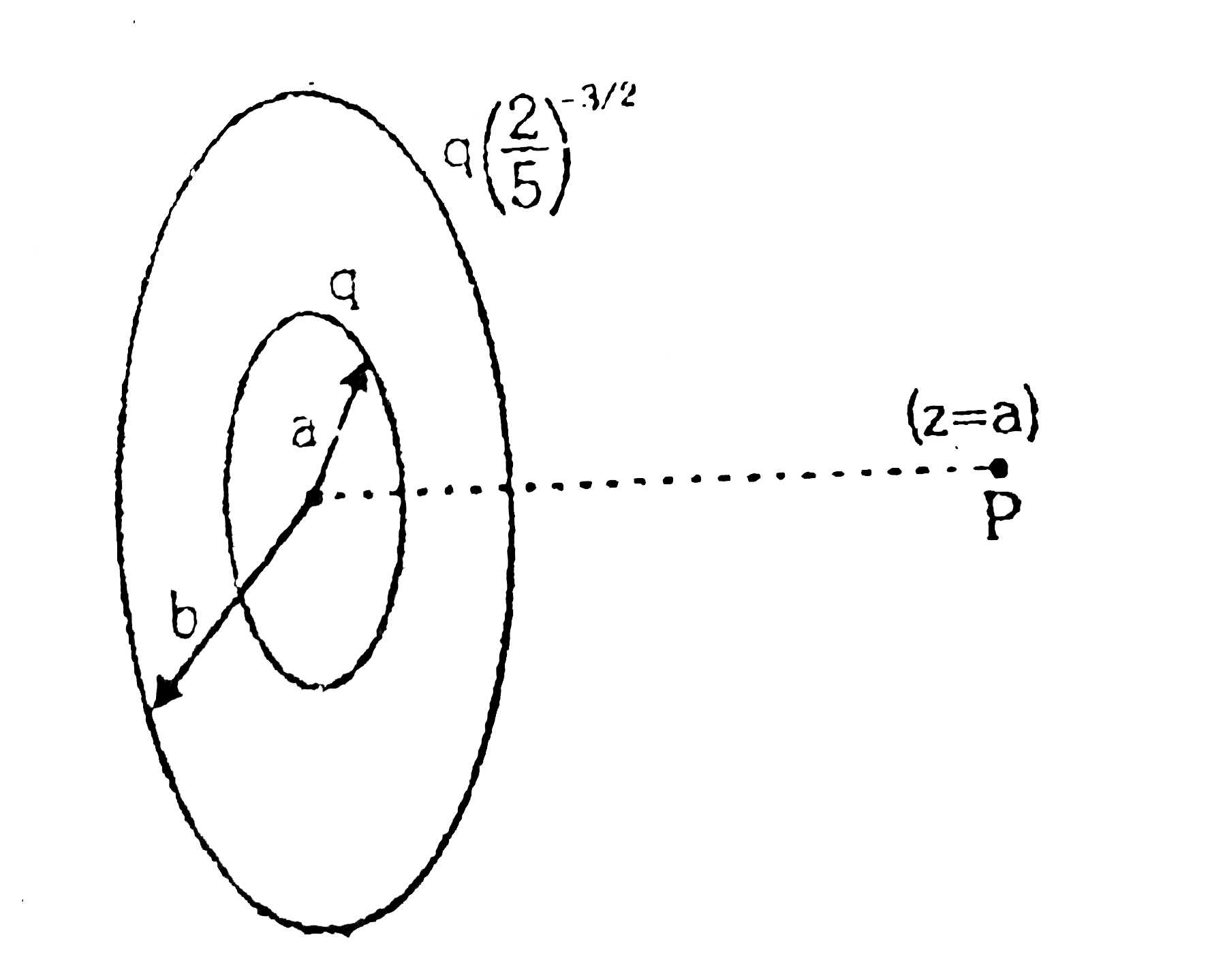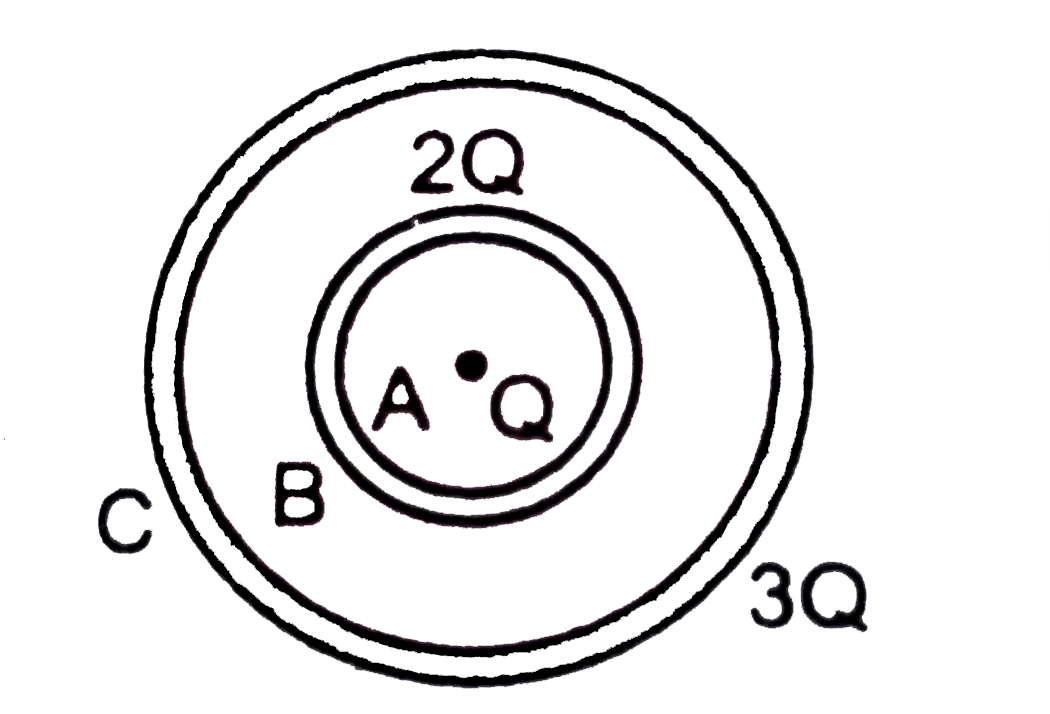Two concentric rings, one of radius a and the other of radius b, have the charges +q, and −(2/5)−3/2q, respectively as shown in fig.

Find the rario b/a if a charge particle palaced on the axis at z =a is i equilibrium. Solution in Gujrati
The correct Answer is:2
The charge at 'P' is in equilibrium
Hence EP=0,→EP=→EPa+→EPb=→0
Kqa(a2+a2)3/2−Kq(25)−3/2(a2+b2)3/2=0⇒ba=2

Topper's Solved these Questions
- MISCELLANEOUSBOOK - ALLEN CHAPTER - MISCELLANEOUSEXERCISE - Exersice-04[B]
16 Videos
- MISCELLANEOUSBOOK - ALLEN CHAPTER - MISCELLANEOUSEXERCISE - Exercise-05(A)
35 Videos
- MISCELLANEOUSBOOK - ALLEN CHAPTER - MISCELLANEOUSEXERCISE - Comprehension 9
2 Videos
- KINEMATICS (MOTION ALONG A STRAIGHT LINE AND MOTION IN A PLANE)BOOK - ALLEN CHAPTER - KINEMATICS (MOTION ALONG A STRAIGHT LINE AND MOTION IN A PLANE)EXERCISE - BEGINNER S BOX-7
8 Videos
- PHYSICAL WORLD, UNITS AND DIMENSIONS & ERRORS IN MEASUREMENT BOOK - ALLEN CHAPTER - PHYSICAL WORLD, UNITS AND DIMENSIONS & ERRORS IN MEASUREMENT EXERCISE - EXERCISE-IV
7 Videos
Similar Questions
Two small balls having the same mass and charge and located on the same vertical at heights h1 and h2 are thrown in the same direction along the horizontal at the same velocity v. The first ball touches the ground at a horizontal distance R from the initial vertical position. At what height h2 will the second ball be at this instant? Neglect any frictional resistance of air and the effect of any induced charge on the ground.
View SolutionOn moving a charge of 20 coulomb by 2cm, 2J of work is done , the potential difference between the points is .
View SolutionFlow cytometry, illustrated in the figure, is a technique used to sort cells by type. The cells are placed in a conducting saline solution which is then forced from a nozzle. The stream breaks up into small droplets, each containing one cell. A metal collar surrounds the stream right at the point where the droplets seprate from the stream. Charging the collar polarizes the conducting liquid, causing the droplets to become charged as they break off from the steam. A leser beam probes the solution just upstream from the charging collar, looking for the presence of certain types of cells. All droplets containing one particular type of cell are given the same charge by the charging collar. Droplets with other desired types of cells receive a different charge, and droplats with no desired cell receive no charge. The charged. The charges droplets then pass between two parallel charged electrodes where they receive a horizontal force that directs force that directs them into different collection tubes, depending on air charge.

View SolutionA football player kicks a ball at an angle of 30∘ with an initial speed of 20 m/s. Assuming that the ball travels in a vertical plane, calculate (a) the time at which the ball reaches the highest point (b) the maximum height reached (c) the horizontal range of the ball (d) the time for which the ball is in the air, (g=10m/s2)
View SolutionAssertion : Gravitational forces do not depend on the medium between the masses.
Reason : Mediating particle responsible for gravitational force is graviton.
View SolutionTwo identical coaxial rings each of radius R are separated by a distance of sqrt3R . They are uniformly charged with charges +Q and -Q respectively. The minimum kinetic energy with which a charged particle (charge +q ) should be projected from the centre of the negatively charged ring along the axis of the rings such that it reaches the centre of the positively charged ring is
View SolutionTwo concentric rings, one of radius a and the other of radius b, have the charges +q, and −(2/5)−3/2q, respectively as shown in fig.

Find the ratio b/a if a charge particle placed on the axis at z =a is in equilibrium.
View SolutionA charge Q is kept in the inner cavity and a charge 2 Q is given to the inner shel. A charge 3 Q is given to the outermost shell, as shown in Fig. 1 (a).22 Find the charges at the surfaces A,B and C.

View SolutionA uniformly charged ring having total charge Q and of radius R is fixed in such a way so that plane of the ring is horizontal. A charged particle of charge q and mass m is in equilibrium at any point lying on y -axis under the combined forces of electric field and earth's gravitational field. Choose the correct statements
View SolutionA ring of radius R with a uniformly distributed charge q as shown in figure. A charge q_(0) , is now placed at the centre of the ring. Find the increment in-the tension in ring.
View SolutionA point charge is projected along the axis of circular ring of charge Q and radius 10√2cm. The distance of the point charge from centre of ring, where acceleration of charged particle is maximum, will be
View SolutionFigure shows two rings having charges Q and - sqrt(5)Q . Find potential difference a and B i.e. (V_(A)-V_(B)) .
View SolutionA short dipole is placed on the axis of a uniformly charged ring (total charge -Q, radius R) at a distance R√2 from centre of ring as shown in figure. Find the Force on the dipole due to that ring

View SolutionTwo concentric coplanar rings one of radius a and the other of radius 2a, have charges qa and qb respectively. A charged particle is in equilibrium on their common axis at a distance a from the common centre. Then the ratio qa/qb is
View SolutionA ring of radius R is with a uniformly distributed charge on it. A charge q is now placed at the centre of the ring. Find the increment in tension in the ring.
View Solution
